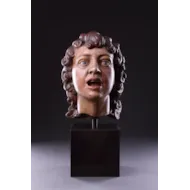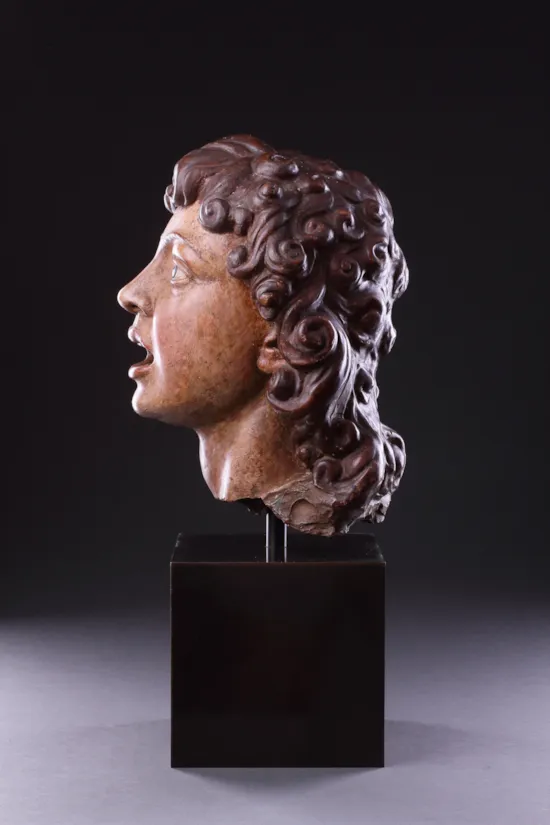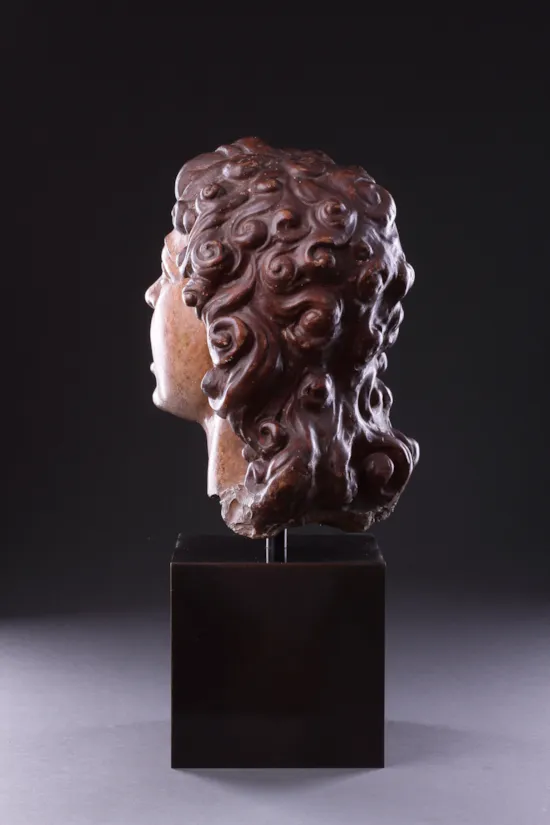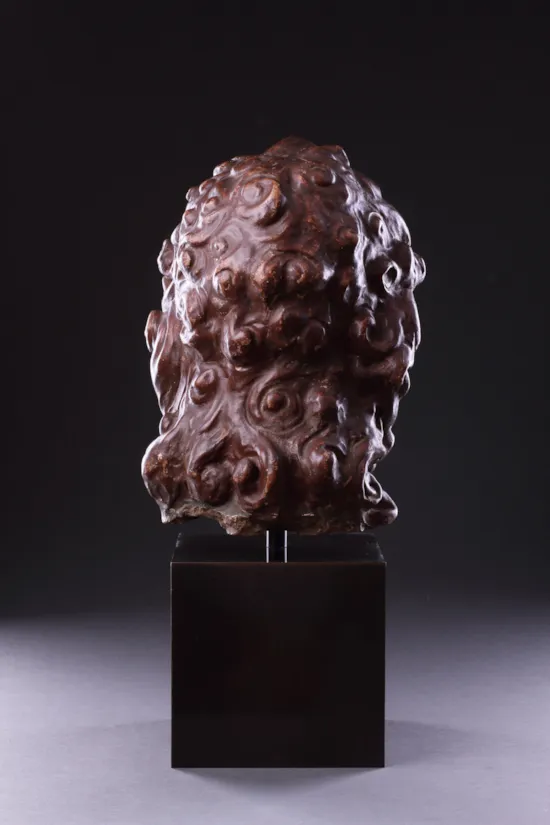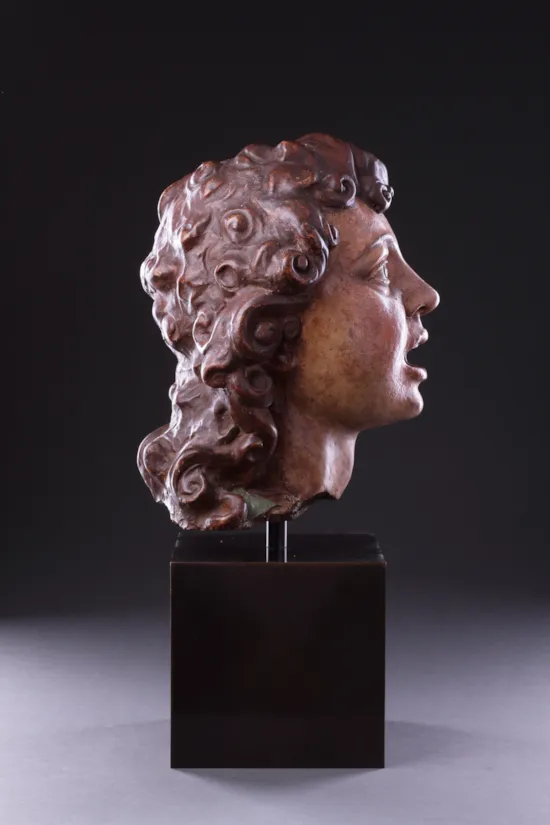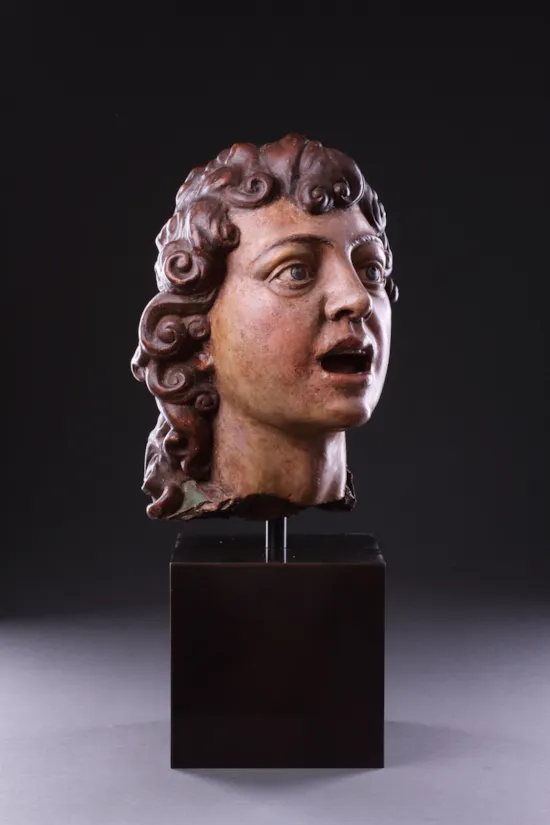A Powerful and Serene Life-Size Italian Terracotta Sculpted Head of a Singing Angel
A Powerful and Serene Life-Size Italian Terracotta Sculpted Head of a Singing Angel with Original Polychrome Decoration
The animated face with mouth wide open in ‘full voice’ with large open eyes raised towards the ‘heavens’ a full head of curly long hair flowing downwards over his ears and neck
Italy
Circa 1500 - 1525
Size: 30cm high, 20cm wide, 20cm deep - 11¾ ins high, 8 ins wide, 8 ins deep / 45cm high - 17¾ ins high (with base)
The animated face with mouth wide open in ‘full voice’ with large open eyes raised towards the ‘heavens’ a full head of curly long hair flowing downwards over his ears and neck
Italy
Circa 1500 - 1525
Size: 30cm high, 20cm wide, 20cm deep - 11¾ ins high, 8 ins wide, 8 ins deep / 45cm high - 17¾ ins high (with base)
A Powerful and Serene Life-Size Italian Terracotta Sculpted Head of a Singing Angel with Original Polychrome Decoration
The animated face with mouth wide open in ‘full voice’ with large open eyes raised towards the ‘heavens’ a full head of curly long hair flowing downwards over his ears and neck
Italy
Circa 1500 - 1525
Size: 30cm high, 20cm wide, 20cm deep - 11¾ ins high, 8 ins wide, 8 ins deep / 45cm high - 17¾ ins high (with base)
The animated face with mouth wide open in ‘full voice’ with large open eyes raised towards the ‘heavens’ a full head of curly long hair flowing downwards over his ears and neck
Italy
Circa 1500 - 1525
Size: 30cm high, 20cm wide, 20cm deep - 11¾ ins high, 8 ins wide, 8 ins deep / 45cm high - 17¾ ins high (with base)
The earliest notated music of western Europe is ‘Gregorian Chant’ with a few other types of chant which were later subsumed (or sometimes suppressed) by the Catholic Church. The tradition of unison choir singing lasted from between the times of St Ambrose (4th century A.D) and Gregory the Great (6th century A.D) up to the present. During the later Middle Ages, a new type of singing involving multiple melodic parts, called ‘organum’, became predominant for certain functions, but initially this polyphony was only sung by soloists. Further developments of this technique included clausulae, conductus and the motet (most notably the isorhythmic motet), which, unlike the renaissance motet, describes a composition with different texts sung simultaneously in different voices. The first evidence of polyphony with more than one singer per part comes in the ‘Old Hall Manuscript (1420, though containing music from the late 14th century), in which there are apparent ‘divisi’, one part dividing into two simultaneously sounding notes.
The ‘choir’, circa 1300, ‘queor’ (part of the church where the choir sings), from the old French ‘cuer, quem’, or architecture (choir of a church) chorus of singers. In Latin chorus ‘choir’ meaning ‘band of singers’ and in English is from circa 1400, ‘quyre’. The re-spelling in the mid 17th century in an attempt to match classical forms, however the pronunciation was not changed.
During the renaissance sacred choral music was the principal type of formally notated music in Western Europe. Throughout the period, hundreds of masses and motets (as well as various other forms) were composed for a cappella choir, though there is some dispute over the role of instruments during certain periods and in certain areas. Some of the better-known composers of this time included Guillaume Dufay, Josquin des Prez, Giovanni Pierluigi da Palestrina, John Dunstable and William Byrd, the glories of renaissance polyphony were choral, sung by choirs of great skill and distinction all over Europe.
Many renaissance artists took inspiration from the ‘choir’ and ‘soloists’ as can be seen in Luca della Robbia’s ‘Cantoria’ in the Museo dell’Opera del Duomo, Florence.
The ‘choir’, circa 1300, ‘queor’ (part of the church where the choir sings), from the old French ‘cuer, quem’, or architecture (choir of a church) chorus of singers. In Latin chorus ‘choir’ meaning ‘band of singers’ and in English is from circa 1400, ‘quyre’. The re-spelling in the mid 17th century in an attempt to match classical forms, however the pronunciation was not changed.
During the renaissance sacred choral music was the principal type of formally notated music in Western Europe. Throughout the period, hundreds of masses and motets (as well as various other forms) were composed for a cappella choir, though there is some dispute over the role of instruments during certain periods and in certain areas. Some of the better-known composers of this time included Guillaume Dufay, Josquin des Prez, Giovanni Pierluigi da Palestrina, John Dunstable and William Byrd, the glories of renaissance polyphony were choral, sung by choirs of great skill and distinction all over Europe.
Many renaissance artists took inspiration from the ‘choir’ and ‘soloists’ as can be seen in Luca della Robbia’s ‘Cantoria’ in the Museo dell’Opera del Duomo, Florence.
Ex Private European collection
Ex Sotheby’s Amsterdam, 2006, lot 129
Ex Tomasso Brothers, Leeds, UK
Ex Sotheby’s Amsterdam, 2006, lot 129
Ex Tomasso Brothers, Leeds, UK
A Powerful and Serene Life-Size Italian Terracotta Sculpted Head of a Singing Angel
